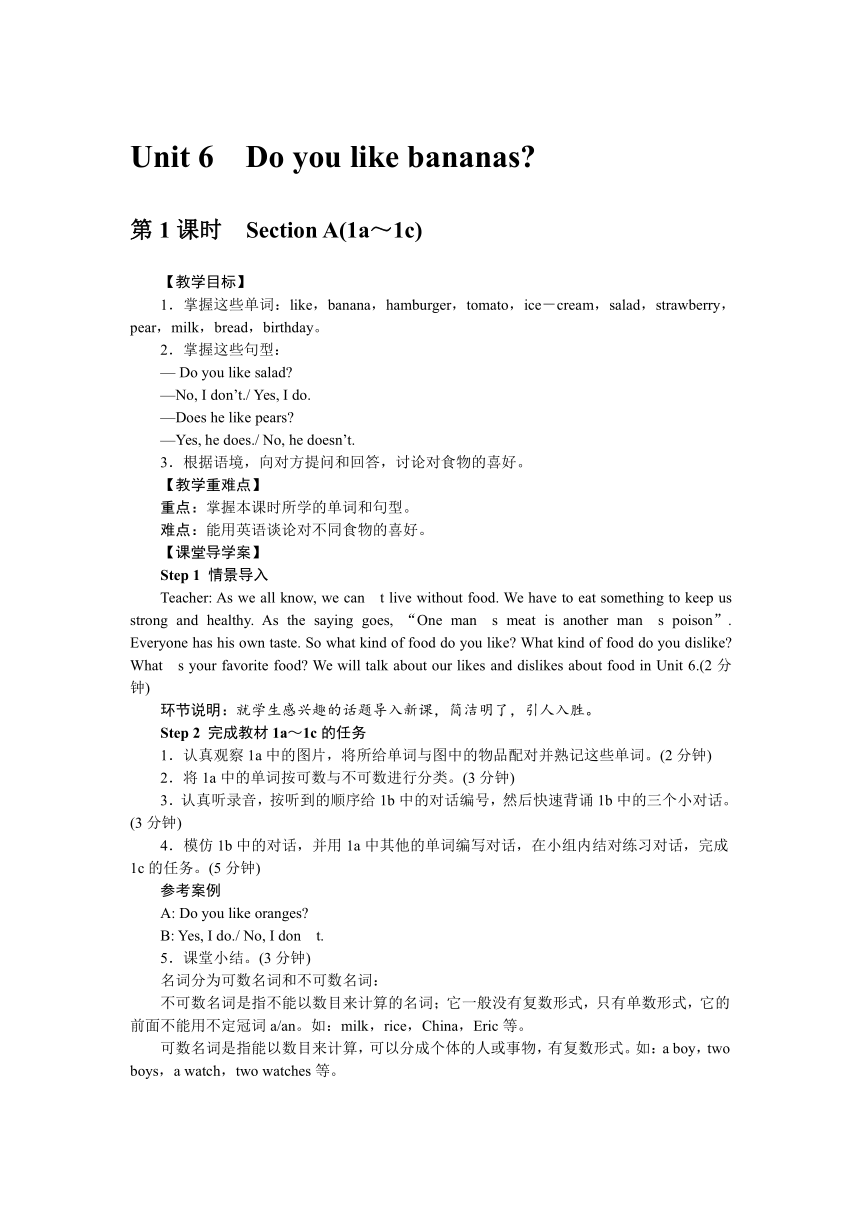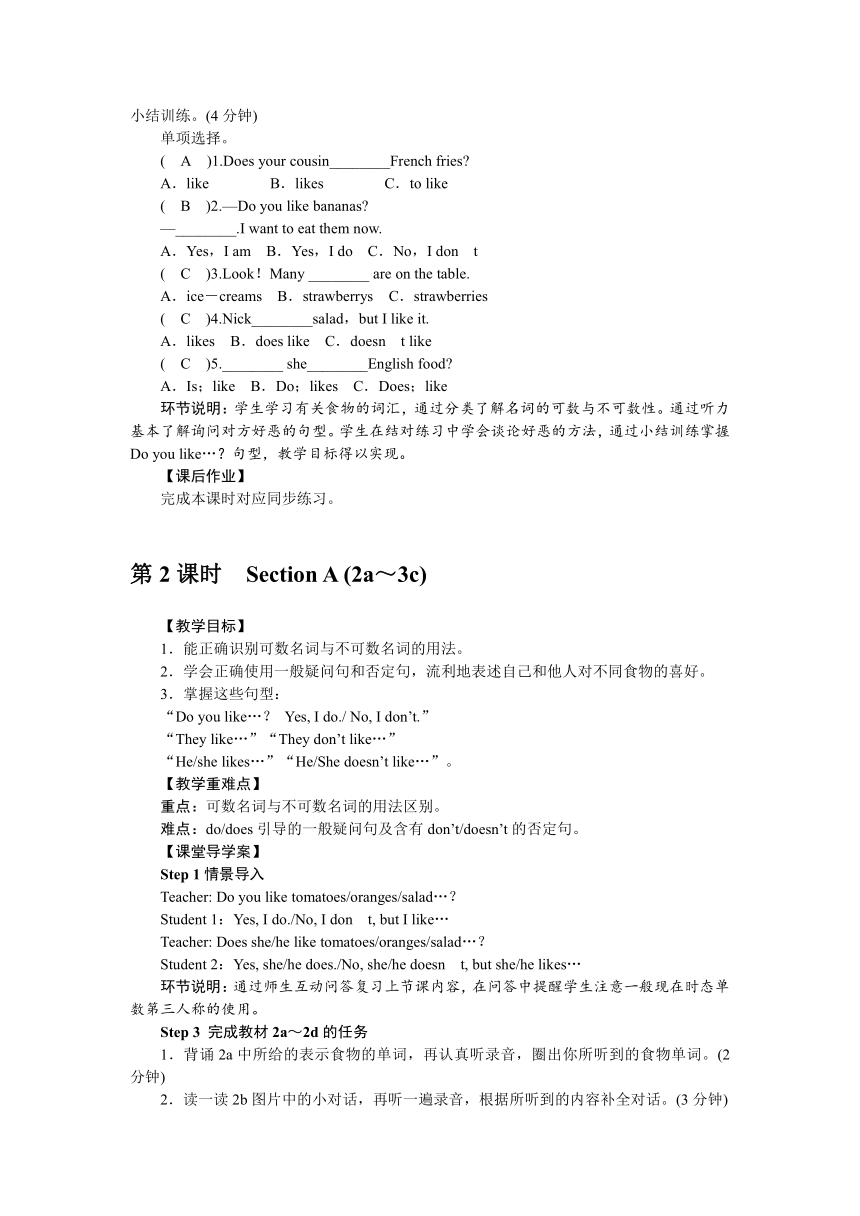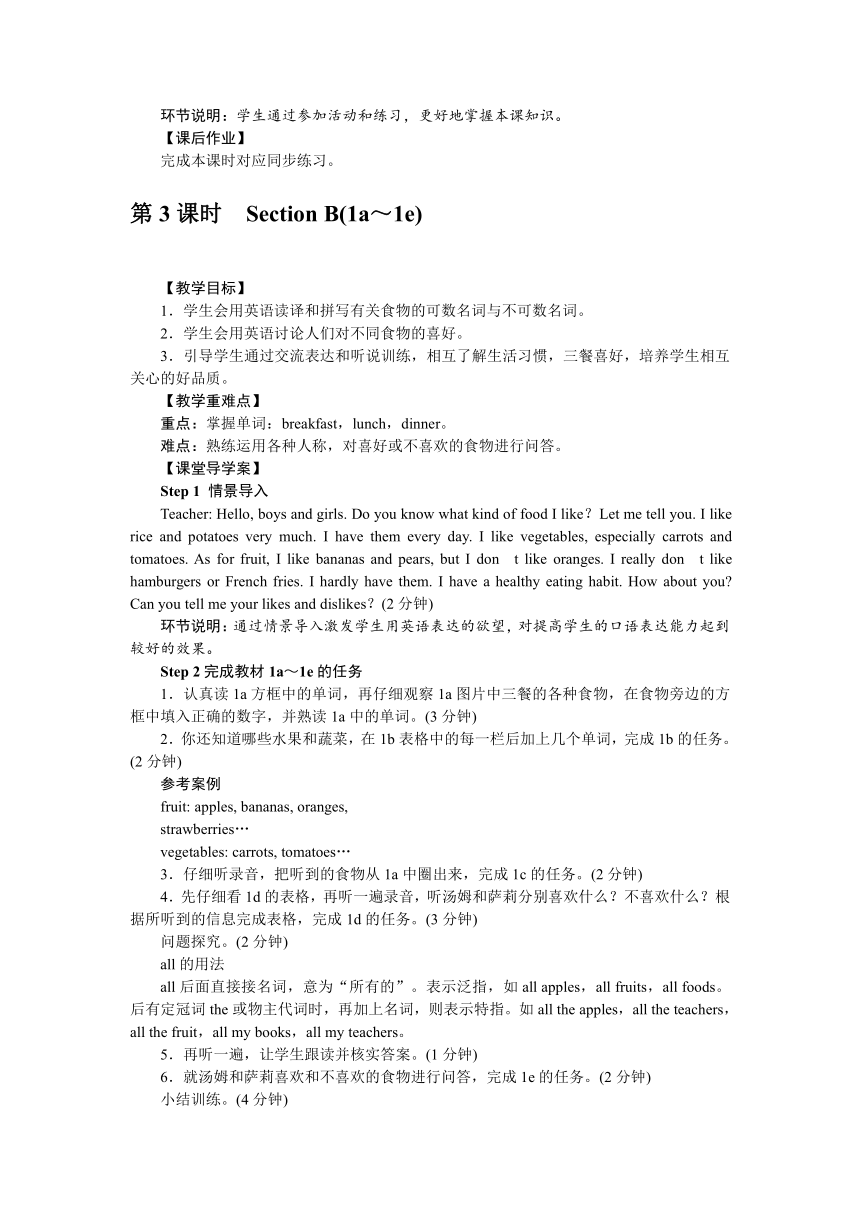Unit 6 Do you like bananas?全单元教案(4课时)
文档属性
| 名称 | Unit 6 Do you like bananas?全单元教案(4课时) |  | |
| 格式 | zip | ||
| 文件大小 | 70.5KB | ||
| 资源类型 | 教案 | ||
| 版本资源 | 人教新目标(Go for it)版 | ||
| 科目 | 英语 | ||
| 更新时间 | 2018-10-24 16:34:59 | ||
图片预览




文档简介
Unit 6 Do you like bananas?
第1课时 Section A(1a~1c)
【教学目标】
1.掌握这些单词:like,banana,hamburger,tomato,ice-cream,salad,strawberry,pear,milk,bread,birthday。
2.掌握这些句型:
— Do you like salad?
—No, I don’t./ Yes, I do.
—Does he like pears?
—Yes, he does./ No, he doesn’t.
3.根据语境,向对方提问和回答,讨论对食物的喜好。
【教学重难点】
重点:掌握本课时所学的单词和句型。
难点:能用英语谈论对不同食物的喜好。
【课堂导学案】
Step 1 情景导入
Teacher: As we all know, we can?t live without food. We have to eat something to keep us strong and healthy. As the saying goes, “One man?s meat is another man?s poison”. Everyone has his own taste. So what kind of food do you like? What kind of food do you dislike? What?s your favorite food? We will talk about our likes and dislikes about food in Unit 6.(2分钟)
环节说明:就学生感兴趣的话题导入新课,简洁明了,引人入胜。
Step 2 完成教材1a~1c的任务
1.认真观察1a中的图片,将所给单词与图中的物品配对并熟记这些单词。(2分钟)
2.将1a中的单词按可数与不可数进行分类。(3分钟)
3.认真听录音,按听到的顺序给1b中的对话编号,然后快速背诵1b中的三个小对话。(3分钟)
4.模仿1b中的对话,并用1a中其他的单词编写对话,在小组内结对练习对话,完成1c的任务。(5分钟)
参考案例
A: Do you like oranges?
B: Yes, I do./ No, I don?t.
5.课堂小结。(3分钟)
名词分为可数名词和不可数名词:
不可数名词是指不能以数目来计算的名词;它一般没有复数形式,只有单数形式,它的前面不能用不定冠词a/an。如:milk,rice,China,Eric等。
可数名词是指能以数目来计算,可以分成个体的人或事物,有复数形式。如:a boy,two boys,a watch,two watches等。
小结训练。(4分钟)
单项选择。
( A )1.Does your cousin________French fries?
A.like B.likes C.to like
( B )2.—Do you like bananas?
—________.I want to eat them now.
A.Yes,I am B.Yes,I do C.No,I don?t
( C )3.Look!Many ________ are on the table.
A.ice-creams B.strawberrys C.strawberries
( C )4.Nick________salad,but I like it.
A.likes B.does like C.doesn?t like
( C )5.________ she________English food?
A.Is;like B.Do;likes C.Does;like
环节说明:学生学习有关食物的词汇,通过分类了解名词的可数与不可数性。通过听力基本了解询问对方好恶的句型。学生在结对练习中学会谈论好恶的方法,通过小结训练掌握Do you like…?句型,教学目标得以实现。
【课后作业】
完成本课时对应同步练习。
第2课时 Section A (2a~3c)
【教学目标】
1.能正确识别可数名词与不可数名词的用法。
2.学会正确使用一般疑问句和否定句,流利地表述自己和他人对不同食物的喜好。
3.掌握这些句型:
“Do you like…? Yes, I do./ No, I don’t.”
“They like…”“They don’t like…”
“He/she likes…”“He/She doesn’t like…”。
【教学重难点】
重点:可数名词与不可数名词的用法区别。
难点:do/does引导的一般疑问句及含有don’t/doesn’t的否定句。
【课堂导学案】
Step 1情景导入
Teacher: Do you like tomatoes/oranges/salad…?
Student 1:Yes, I do./No, I don?t, but I like…
Teacher: Does she/he like tomatoes/oranges/salad…?
Student 2:Yes, she/he does./No, she/he doesn?t, but she/he likes…
环节说明:通过师生互动问答复习上节课内容,在问答中提醒学生注意一般现在时态单数第三人称的使用。
Step 3 完成教材2a~2d的任务
1.背诵2a中所给的表示食物的单词,再认真听录音,圈出你所听到的食物单词。(2分钟)
2.读一读2b图片中的小对话,再听一遍录音,根据所听到的内容补全对话。(3分钟)
3.练习2b中的对话,然后小组内两两提问,让学生谈谈自己的真实情况,完成2c的任务。(3分钟)
参考案例
①A:Do you like broccoli?
B:Yes,I do./No,I don?t.
②A:Let?s have ice-cream!
B:Oh,no.
A:No?
B:I don?t like ice-cream.
4.先自己读对话,然后在小组内分角色表演对话。老师选三组同学分角色表演对话进行比赛。完成2d的任务。(5分钟)
小结训练。(5分钟)
用所给单词的适当形式填空。
1.Do you __like__ (like) hamburgers?
2.Let?s __have__ (have) some milk.
3.I __don?t__ __like__ (not like) bread.
4.How about __having__ (have) some apples?
5.__Tom?s__ (Tom) birthday is next week.
6.Jack __likes__ (like) strawberries.
7.That sounds __good__ (well).
8.Does Sally __like__ (like) pears?
9.I like __tomatoes__ (tomato).
10.Does he like __bread__ (bread)?
环节说明:在读、写中强化知识目标,让学生更好地掌握谈论自己和他人喜好的方法。
Step 3完成教材3a~3c的任务
1.认真读3a的5个句子,并在括号内正确的单词下面画线,使句子正确完整。(2分钟)
2.学生说出答案,教师核对,然后让学生大声朗读这些句子,并背诵。(2分钟)
3.认真读3b的几个句子,将其编号,组成对话,然后读背。(2分钟)
4.做食物调查。用“Do you like…”句型就3c表格中的食物向小组成员提问。找出他们喜欢和不喜欢的食物,并把结果登记在表格中。(4分钟)
小结训练。(4分钟)
根据图示,完成句子。
name food 汉堡包 西红柿 草莓 冰激凌
Paul
Emma
1.Paul likes tomatoes and __ice-cream__.
2.Paul doesn?t like hamburgers or __strawberries__.
3.Emma likes __hamburgers__ and strawberries.
4.Emma __doesn?t__ like tomatoes or ice-cream.
5.Paul likes tomatoes, but Emma __doesn?t__ like them.
环节说明:学生通过参加活动和练习,更好地掌握本课知识。
【课后作业】
完成本课时对应同步练习。
第3课时 Section B(1a~1e)
【教学目标】
1.学生会用英语读译和拼写有关食物的可数名词与不可数名词。
2.学生会用英语讨论人们对不同食物的喜好。
3.引导学生通过交流表达和听说训练,相互了解生活习惯,三餐喜好,培养学生相互关心的好品质。
【教学重难点】
重点:掌握单词:breakfast,lunch,dinner。
难点:熟练运用各种人称,对喜好或不喜欢的食物进行问答。
【课堂导学案】
Step 1 情景导入
Teacher: Hello, boys and girls. Do you know what kind of food I like?Let me tell you. I like rice and potatoes very much. I have them every day. I like vegetables, especially carrots and tomatoes. As for fruit, I like bananas and pears, but I don?t like oranges. I really don?t like hamburgers or French fries. I hardly have them. I have a healthy eating habit. How about you? Can you tell me your likes and dislikes?(2分钟)
环节说明:通过情景导入激发学生用英语表达的欲望,对提高学生的口语表达能力起到较好的效果。
Step 2完成教材1a~1e的任务
1.认真读1a方框中的单词,再仔细观察1a图片中三餐的各种食物,在食物旁边的方框中填入正确的数字,并熟读1a中的单词。(3分钟)
2.你还知道哪些水果和蔬菜,在1b表格中的每一栏后加上几个单词,完成1b的任务。(2分钟)
参考案例
fruit: apples, bananas, oranges,
strawberries…
vegetables: carrots, tomatoes…
3.仔细听录音,把听到的食物从1a中圈出来,完成1c的任务。(2分钟)
4.先仔细看1d的表格,再听一遍录音,听汤姆和萨莉分别喜欢什么?不喜欢什么?根据所听到的信息完成表格,完成1d的任务。(3分钟)
问题探究。(2分钟)
all的用法
all后面直接接名词,意为“所有的”。表示泛指,如all apples,all fruits,all foods。后有定冠词the或物主代词时,再加上名词,则表示特指。如all the apples,all the teachers,all the fruit,all my books,all my teachers。
5.再听一遍,让学生跟读并核实答案。(1分钟)
6.就汤姆和萨莉喜欢和不喜欢的食物进行问答,完成1e的任务。(2分钟)
小结训练。(4分钟)
用所给单词的适当形式填空。
1.These are __tomatoes__ (tomato).
2.He likes __strawberries__ (strawberry).
3.Tony __doesn?t__like__ (not like) rice.
4.—__Does__ Sally __like__ (like) vegetables?
—Yes, she does.
5.Tomatoes and carrots are __vegetables__(vegetable).
环节说明:通过对食物名词的分类,让学生掌握了食物的类型。通过听说的训练,让学生掌握了谈论某人好恶的句型。
Step 3 问题探究
1.Do you like ________ for dinner?
A.chicken B.chickens
C.chickenes D.an chicken
2.Where do you ________?
A.have a breakfast B.breakfasts
C.have breakfasts D.have breakfast
答案选择D,三餐breakfast,lunch,dinner 前面不加冠词,只能用单数。
3.In the shop,you can buy ________ things.
A.a lot B.much
C.lots of D.a lots of
答案选择C,lots of 修饰可数名词的复数,much 修饰不可数名词,a lot 修饰动词。
4.My brother ________ very much.
A.like banana B.likes bananas
C.like bananas D.likes banana
答案选择B,My brother 是第三人称单数,谓语动词要用likes,表示一类水果要用复数。
【课后作业】
完成本课时对应同步练习。
第4课时 Section B(2a~Self Check)
【教学目标】
1.指导学生通过阅读,能够准确地找出并运用重点句型“What do you like for breakfast?/What fruit do you like?”等进行对话回答。
2.了解食物安全与健康问题,让学生养成良好的饮食习惯。
3.通过Self Check检测学生对本单元的学习效果,并对所学知识进行巩固和练习。
【教学重难点】
重点:在对话过程中,学生能正确区分不同的人称,并能在句子中对谓语动词做出相应的变化。
难点:第三人称单数作主语时谓语动词相应的变化以及助动词do/does的用法。
【课堂导学案】
Step 1情景导入
Teacher: An apple a day keeps the doctor away. As we all know, eating healthy food will help us keep healthy. So what is healthy food and what is unhealthy food? What do you have for breakfast, lunch and dinner? Now, let?s get to know what Sandra Clark eats for three meals.(2分钟)
环节说明:以谚语“An apple a day keeps the doctor away.”作为开场白,教育学生养成健康的饮食习惯,并自然地引入新课内容。
Step 2完成教材2b~2c的任务
1.认真看2a表格中的食物,你认为哪种食物健康?在Yes、Maybe或No下打勾。(2分钟)
2.快速朗读2b的杂志,了解对话的内容,然后仔细阅读这篇杂志文章,圈出文中的食物名词。(3分钟)
3.大声朗读并背诵2b。(3分钟)
4.看2c,写五个句子,谈谈辛迪的饮食习惯,然后把你写的句子在小组内念给大家听,完成2c的任务。(4分钟)
小结训练。(5分钟)
单项选择。
( D )1.Hamburgers________healthy.
A.is B.are C.isn?t D.aren?t
( A )2.Li Lei speaks English very________.
A.well B.good C.nice D.great
( C )3.Judy asks Bob____ his likes and dislikes.
A.with B.at C.about D.in
( B )4.Tom?s ________ habits are good.
A.eat B.eating
C.eats D.eatting
( A )5.—Do you like chicken and vegetables________lunch?
—Yes,I do.
A.for B.as C.on D.at
( C )6.She wants some fruit________.
A.eats B.eating C.to eat D.eat
环节说明:通过学习2b的杂志文章,让学生了解了健康的饮食习惯,巩固了学生对目标语言的理解和掌握。小结训练重点疏理本课知识点,让学生掌握了本节重点知识。
Step 3完成教材3a~3b的任务
1.认真看3a的表格,填好自己一日三餐喜欢和不喜欢的食物,再用“Do you like…for breakfast/lunch/dinner?”句型询问你的同伴一日三餐喜欢和不喜欢的食物,完成表格。(4分钟)
2.完成3b的任务。根据上面3a的调查表,写出你和同伴一日三餐喜欢吃和不喜欢吃的东西,然后念给全班同学听。(4分钟)
参考案例
For breakfast,I like…,but I don?t like…
For lunch,…
And for dinner,…
For breakfast,…likes…but he/she doesn?t like…
For lunch,…
And for dinner,…
环节说明:通过说、写的练习,让学生谈论自己和同伴的一日三餐,使他们把所学的知识运用于实际,巩固了学生对目标语言的理解和运用。
Step 4完成教材Self Check的任务
1.认真读“1”方框中的名词,回忆名词单数变复数的规则,按规则分别把它们的复数形式写在相应的栏目里,完成“1”的任务,然后教师作出总结强调。(3分钟)
2.你喜欢和不喜欢什么食物、运动、颜色,完成你自己的两张介绍卡,完成“2”的任务。(2分钟)
参考案例
I like…(food)
…(sports)
…(colors)I don?t like…(food)
…(sports)
…(colors)
3.你知道你父母喜欢什么食物、运动和颜色吗?他们又不喜欢什么食物、运动和颜色?请至少写5句话谈一谈,然后念给同学们听。(5分钟)
参考案例
I love my parents very much. And I know them very well.
My father likes…,but he doesn?t like…[food]
He likes…,but he doesn?t like…[sports]
He likes …,but he doesn?t like…[colors]
My mother likes…,but she doesn?t like…[food]
She likes…,but she doesn?t like…[sports]
She likes…,but she doesn?t like…[colors]
小结训练。(5分钟)
根据汉语提示完成句子,每空一词。
1.午餐我喜欢吃蔬菜。
I like vegetables __for__ __lunch__.
2.体育明星吃得非常好。
Sports stars eat very __well__.
3.彼得每天早餐吃三个鸡蛋,一个苹果,他非常健康。
Peter has three eggs, an apple for __breakfast__. He is very __healthy__.
4.她喜欢胡萝卜,但她不喜欢沙拉。
She __likes__ carrots, but she __doesn?t__ like salad.
5.她不想长胖。
She doesn?t want __to__ __be__ __fat__.
环节说明:通过谈论对食物的爱好,延伸到对运动和颜色的爱好的谈论,让学生更全面地理解和掌握了目标语言——谈论好恶。通过复习名词单数变复数,让学生更好地掌握了名词单数变复数的规则。
Step 5 问题探究
1.well的用法
(1)—你好吗?—我很好。
__—How__are__you?—I?m__well.__
(2)他打篮球打得很好。
__He__plays__basketball__well.__
Well意为“好的”,指身体好时,是形容词,做表语。大部分情况下是作为副词来用,修饰动词。
2.healthy的用法
(1)我很健康。
__I__am__healthy.__
(2)他是一位健康的老人。
__He__is__a__healthy__old__man.__
healthey 意为“健康的”,是形容词,常在句子中作表语和定语,它的名词形式是health。它的反义词为unhealthy。
3.want 的用法
(1)我想要一本书。
__I__want__a__book.__
(2)这本书很好,我想要它。
__This__book__is__good,I__want__it.__
(3)我想打篮球。
__I__want__to__play__basketball.__
(4)我想让你和我一起打篮球。
__I__want__you__to__play__basketball__with__me.__
want 意为“想要”,常用结构为:
①want sth.想要某物;
②want to do sth.想要做某事;
③want sb.to do sth.想要某人做某事。
④I really like salad.我非常地喜欢沙拉。
really常放在动词、形容词和副词前,起强调作用。如:
He really likes vegetable salad.他的确很喜欢蔬菜沙拉。
I am really happy now.我现在真的很高兴。
【课后作业】
完成本课时对应同步练习。
第1课时 Section A(1a~1c)
【教学目标】
1.掌握这些单词:like,banana,hamburger,tomato,ice-cream,salad,strawberry,pear,milk,bread,birthday。
2.掌握这些句型:
— Do you like salad?
—No, I don’t./ Yes, I do.
—Does he like pears?
—Yes, he does./ No, he doesn’t.
3.根据语境,向对方提问和回答,讨论对食物的喜好。
【教学重难点】
重点:掌握本课时所学的单词和句型。
难点:能用英语谈论对不同食物的喜好。
【课堂导学案】
Step 1 情景导入
Teacher: As we all know, we can?t live without food. We have to eat something to keep us strong and healthy. As the saying goes, “One man?s meat is another man?s poison”. Everyone has his own taste. So what kind of food do you like? What kind of food do you dislike? What?s your favorite food? We will talk about our likes and dislikes about food in Unit 6.(2分钟)
环节说明:就学生感兴趣的话题导入新课,简洁明了,引人入胜。
Step 2 完成教材1a~1c的任务
1.认真观察1a中的图片,将所给单词与图中的物品配对并熟记这些单词。(2分钟)
2.将1a中的单词按可数与不可数进行分类。(3分钟)
3.认真听录音,按听到的顺序给1b中的对话编号,然后快速背诵1b中的三个小对话。(3分钟)
4.模仿1b中的对话,并用1a中其他的单词编写对话,在小组内结对练习对话,完成1c的任务。(5分钟)
参考案例
A: Do you like oranges?
B: Yes, I do./ No, I don?t.
5.课堂小结。(3分钟)
名词分为可数名词和不可数名词:
不可数名词是指不能以数目来计算的名词;它一般没有复数形式,只有单数形式,它的前面不能用不定冠词a/an。如:milk,rice,China,Eric等。
可数名词是指能以数目来计算,可以分成个体的人或事物,有复数形式。如:a boy,two boys,a watch,two watches等。
小结训练。(4分钟)
单项选择。
( A )1.Does your cousin________French fries?
A.like B.likes C.to like
( B )2.—Do you like bananas?
—________.I want to eat them now.
A.Yes,I am B.Yes,I do C.No,I don?t
( C )3.Look!Many ________ are on the table.
A.ice-creams B.strawberrys C.strawberries
( C )4.Nick________salad,but I like it.
A.likes B.does like C.doesn?t like
( C )5.________ she________English food?
A.Is;like B.Do;likes C.Does;like
环节说明:学生学习有关食物的词汇,通过分类了解名词的可数与不可数性。通过听力基本了解询问对方好恶的句型。学生在结对练习中学会谈论好恶的方法,通过小结训练掌握Do you like…?句型,教学目标得以实现。
【课后作业】
完成本课时对应同步练习。
第2课时 Section A (2a~3c)
【教学目标】
1.能正确识别可数名词与不可数名词的用法。
2.学会正确使用一般疑问句和否定句,流利地表述自己和他人对不同食物的喜好。
3.掌握这些句型:
“Do you like…? Yes, I do./ No, I don’t.”
“They like…”“They don’t like…”
“He/she likes…”“He/She doesn’t like…”。
【教学重难点】
重点:可数名词与不可数名词的用法区别。
难点:do/does引导的一般疑问句及含有don’t/doesn’t的否定句。
【课堂导学案】
Step 1情景导入
Teacher: Do you like tomatoes/oranges/salad…?
Student 1:Yes, I do./No, I don?t, but I like…
Teacher: Does she/he like tomatoes/oranges/salad…?
Student 2:Yes, she/he does./No, she/he doesn?t, but she/he likes…
环节说明:通过师生互动问答复习上节课内容,在问答中提醒学生注意一般现在时态单数第三人称的使用。
Step 3 完成教材2a~2d的任务
1.背诵2a中所给的表示食物的单词,再认真听录音,圈出你所听到的食物单词。(2分钟)
2.读一读2b图片中的小对话,再听一遍录音,根据所听到的内容补全对话。(3分钟)
3.练习2b中的对话,然后小组内两两提问,让学生谈谈自己的真实情况,完成2c的任务。(3分钟)
参考案例
①A:Do you like broccoli?
B:Yes,I do./No,I don?t.
②A:Let?s have ice-cream!
B:Oh,no.
A:No?
B:I don?t like ice-cream.
4.先自己读对话,然后在小组内分角色表演对话。老师选三组同学分角色表演对话进行比赛。完成2d的任务。(5分钟)
小结训练。(5分钟)
用所给单词的适当形式填空。
1.Do you __like__ (like) hamburgers?
2.Let?s __have__ (have) some milk.
3.I __don?t__ __like__ (not like) bread.
4.How about __having__ (have) some apples?
5.__Tom?s__ (Tom) birthday is next week.
6.Jack __likes__ (like) strawberries.
7.That sounds __good__ (well).
8.Does Sally __like__ (like) pears?
9.I like __tomatoes__ (tomato).
10.Does he like __bread__ (bread)?
环节说明:在读、写中强化知识目标,让学生更好地掌握谈论自己和他人喜好的方法。
Step 3完成教材3a~3c的任务
1.认真读3a的5个句子,并在括号内正确的单词下面画线,使句子正确完整。(2分钟)
2.学生说出答案,教师核对,然后让学生大声朗读这些句子,并背诵。(2分钟)
3.认真读3b的几个句子,将其编号,组成对话,然后读背。(2分钟)
4.做食物调查。用“Do you like…”句型就3c表格中的食物向小组成员提问。找出他们喜欢和不喜欢的食物,并把结果登记在表格中。(4分钟)
小结训练。(4分钟)
根据图示,完成句子。
name food 汉堡包 西红柿 草莓 冰激凌
Paul
Emma
1.Paul likes tomatoes and __ice-cream__.
2.Paul doesn?t like hamburgers or __strawberries__.
3.Emma likes __hamburgers__ and strawberries.
4.Emma __doesn?t__ like tomatoes or ice-cream.
5.Paul likes tomatoes, but Emma __doesn?t__ like them.
环节说明:学生通过参加活动和练习,更好地掌握本课知识。
【课后作业】
完成本课时对应同步练习。
第3课时 Section B(1a~1e)
【教学目标】
1.学生会用英语读译和拼写有关食物的可数名词与不可数名词。
2.学生会用英语讨论人们对不同食物的喜好。
3.引导学生通过交流表达和听说训练,相互了解生活习惯,三餐喜好,培养学生相互关心的好品质。
【教学重难点】
重点:掌握单词:breakfast,lunch,dinner。
难点:熟练运用各种人称,对喜好或不喜欢的食物进行问答。
【课堂导学案】
Step 1 情景导入
Teacher: Hello, boys and girls. Do you know what kind of food I like?Let me tell you. I like rice and potatoes very much. I have them every day. I like vegetables, especially carrots and tomatoes. As for fruit, I like bananas and pears, but I don?t like oranges. I really don?t like hamburgers or French fries. I hardly have them. I have a healthy eating habit. How about you? Can you tell me your likes and dislikes?(2分钟)
环节说明:通过情景导入激发学生用英语表达的欲望,对提高学生的口语表达能力起到较好的效果。
Step 2完成教材1a~1e的任务
1.认真读1a方框中的单词,再仔细观察1a图片中三餐的各种食物,在食物旁边的方框中填入正确的数字,并熟读1a中的单词。(3分钟)
2.你还知道哪些水果和蔬菜,在1b表格中的每一栏后加上几个单词,完成1b的任务。(2分钟)
参考案例
fruit: apples, bananas, oranges,
strawberries…
vegetables: carrots, tomatoes…
3.仔细听录音,把听到的食物从1a中圈出来,完成1c的任务。(2分钟)
4.先仔细看1d的表格,再听一遍录音,听汤姆和萨莉分别喜欢什么?不喜欢什么?根据所听到的信息完成表格,完成1d的任务。(3分钟)
问题探究。(2分钟)
all的用法
all后面直接接名词,意为“所有的”。表示泛指,如all apples,all fruits,all foods。后有定冠词the或物主代词时,再加上名词,则表示特指。如all the apples,all the teachers,all the fruit,all my books,all my teachers。
5.再听一遍,让学生跟读并核实答案。(1分钟)
6.就汤姆和萨莉喜欢和不喜欢的食物进行问答,完成1e的任务。(2分钟)
小结训练。(4分钟)
用所给单词的适当形式填空。
1.These are __tomatoes__ (tomato).
2.He likes __strawberries__ (strawberry).
3.Tony __doesn?t__like__ (not like) rice.
4.—__Does__ Sally __like__ (like) vegetables?
—Yes, she does.
5.Tomatoes and carrots are __vegetables__(vegetable).
环节说明:通过对食物名词的分类,让学生掌握了食物的类型。通过听说的训练,让学生掌握了谈论某人好恶的句型。
Step 3 问题探究
1.Do you like ________ for dinner?
A.chicken B.chickens
C.chickenes D.an chicken
2.Where do you ________?
A.have a breakfast B.breakfasts
C.have breakfasts D.have breakfast
答案选择D,三餐breakfast,lunch,dinner 前面不加冠词,只能用单数。
3.In the shop,you can buy ________ things.
A.a lot B.much
C.lots of D.a lots of
答案选择C,lots of 修饰可数名词的复数,much 修饰不可数名词,a lot 修饰动词。
4.My brother ________ very much.
A.like banana B.likes bananas
C.like bananas D.likes banana
答案选择B,My brother 是第三人称单数,谓语动词要用likes,表示一类水果要用复数。
【课后作业】
完成本课时对应同步练习。
第4课时 Section B(2a~Self Check)
【教学目标】
1.指导学生通过阅读,能够准确地找出并运用重点句型“What do you like for breakfast?/What fruit do you like?”等进行对话回答。
2.了解食物安全与健康问题,让学生养成良好的饮食习惯。
3.通过Self Check检测学生对本单元的学习效果,并对所学知识进行巩固和练习。
【教学重难点】
重点:在对话过程中,学生能正确区分不同的人称,并能在句子中对谓语动词做出相应的变化。
难点:第三人称单数作主语时谓语动词相应的变化以及助动词do/does的用法。
【课堂导学案】
Step 1情景导入
Teacher: An apple a day keeps the doctor away. As we all know, eating healthy food will help us keep healthy. So what is healthy food and what is unhealthy food? What do you have for breakfast, lunch and dinner? Now, let?s get to know what Sandra Clark eats for three meals.(2分钟)
环节说明:以谚语“An apple a day keeps the doctor away.”作为开场白,教育学生养成健康的饮食习惯,并自然地引入新课内容。
Step 2完成教材2b~2c的任务
1.认真看2a表格中的食物,你认为哪种食物健康?在Yes、Maybe或No下打勾。(2分钟)
2.快速朗读2b的杂志,了解对话的内容,然后仔细阅读这篇杂志文章,圈出文中的食物名词。(3分钟)
3.大声朗读并背诵2b。(3分钟)
4.看2c,写五个句子,谈谈辛迪的饮食习惯,然后把你写的句子在小组内念给大家听,完成2c的任务。(4分钟)
小结训练。(5分钟)
单项选择。
( D )1.Hamburgers________healthy.
A.is B.are C.isn?t D.aren?t
( A )2.Li Lei speaks English very________.
A.well B.good C.nice D.great
( C )3.Judy asks Bob____ his likes and dislikes.
A.with B.at C.about D.in
( B )4.Tom?s ________ habits are good.
A.eat B.eating
C.eats D.eatting
( A )5.—Do you like chicken and vegetables________lunch?
—Yes,I do.
A.for B.as C.on D.at
( C )6.She wants some fruit________.
A.eats B.eating C.to eat D.eat
环节说明:通过学习2b的杂志文章,让学生了解了健康的饮食习惯,巩固了学生对目标语言的理解和掌握。小结训练重点疏理本课知识点,让学生掌握了本节重点知识。
Step 3完成教材3a~3b的任务
1.认真看3a的表格,填好自己一日三餐喜欢和不喜欢的食物,再用“Do you like…for breakfast/lunch/dinner?”句型询问你的同伴一日三餐喜欢和不喜欢的食物,完成表格。(4分钟)
2.完成3b的任务。根据上面3a的调查表,写出你和同伴一日三餐喜欢吃和不喜欢吃的东西,然后念给全班同学听。(4分钟)
参考案例
For breakfast,I like…,but I don?t like…
For lunch,…
And for dinner,…
For breakfast,…likes…but he/she doesn?t like…
For lunch,…
And for dinner,…
环节说明:通过说、写的练习,让学生谈论自己和同伴的一日三餐,使他们把所学的知识运用于实际,巩固了学生对目标语言的理解和运用。
Step 4完成教材Self Check的任务
1.认真读“1”方框中的名词,回忆名词单数变复数的规则,按规则分别把它们的复数形式写在相应的栏目里,完成“1”的任务,然后教师作出总结强调。(3分钟)
2.你喜欢和不喜欢什么食物、运动、颜色,完成你自己的两张介绍卡,完成“2”的任务。(2分钟)
参考案例
I like…(food)
…(sports)
…(colors)I don?t like…(food)
…(sports)
…(colors)
3.你知道你父母喜欢什么食物、运动和颜色吗?他们又不喜欢什么食物、运动和颜色?请至少写5句话谈一谈,然后念给同学们听。(5分钟)
参考案例
I love my parents very much. And I know them very well.
My father likes…,but he doesn?t like…[food]
He likes…,but he doesn?t like…[sports]
He likes …,but he doesn?t like…[colors]
My mother likes…,but she doesn?t like…[food]
She likes…,but she doesn?t like…[sports]
She likes…,but she doesn?t like…[colors]
小结训练。(5分钟)
根据汉语提示完成句子,每空一词。
1.午餐我喜欢吃蔬菜。
I like vegetables __for__ __lunch__.
2.体育明星吃得非常好。
Sports stars eat very __well__.
3.彼得每天早餐吃三个鸡蛋,一个苹果,他非常健康。
Peter has three eggs, an apple for __breakfast__. He is very __healthy__.
4.她喜欢胡萝卜,但她不喜欢沙拉。
She __likes__ carrots, but she __doesn?t__ like salad.
5.她不想长胖。
She doesn?t want __to__ __be__ __fat__.
环节说明:通过谈论对食物的爱好,延伸到对运动和颜色的爱好的谈论,让学生更全面地理解和掌握了目标语言——谈论好恶。通过复习名词单数变复数,让学生更好地掌握了名词单数变复数的规则。
Step 5 问题探究
1.well的用法
(1)—你好吗?—我很好。
__—How__are__you?—I?m__well.__
(2)他打篮球打得很好。
__He__plays__basketball__well.__
Well意为“好的”,指身体好时,是形容词,做表语。大部分情况下是作为副词来用,修饰动词。
2.healthy的用法
(1)我很健康。
__I__am__healthy.__
(2)他是一位健康的老人。
__He__is__a__healthy__old__man.__
healthey 意为“健康的”,是形容词,常在句子中作表语和定语,它的名词形式是health。它的反义词为unhealthy。
3.want 的用法
(1)我想要一本书。
__I__want__a__book.__
(2)这本书很好,我想要它。
__This__book__is__good,I__want__it.__
(3)我想打篮球。
__I__want__to__play__basketball.__
(4)我想让你和我一起打篮球。
__I__want__you__to__play__basketball__with__me.__
want 意为“想要”,常用结构为:
①want sth.想要某物;
②want to do sth.想要做某事;
③want sb.to do sth.想要某人做某事。
④I really like salad.我非常地喜欢沙拉。
really常放在动词、形容词和副词前,起强调作用。如:
He really likes vegetable salad.他的确很喜欢蔬菜沙拉。
I am really happy now.我现在真的很高兴。
【课后作业】
完成本课时对应同步练习。
同课章节目录
- starters 预备篇(2012秋审查)
- Unit 1 Good morning !
- Unit 2 What’s this in English?
- Unit 3 What color is it ?
- Unit 1 My name's Gina.
- Section A
- Section B
- Unit 2 This is my sister.
- Section A
- Section B
- Unit 3 Is this your pencil?
- Section A
- Section B
- Unit 4 Where's my schoolbag?
- Section A
- Section B
- Unit 5 Do you have a soccer ball?
- Section A
- Section B
- Unit 6 Do you like bananas?
- Section A
- Section B
- Unit 7 How much are these socks?
- Section A
- Section B
- Unit 8 When is your birthday?
- Section A
- Section B
- Unit 9 My favorite subject is science.
- Section A
- Section B
